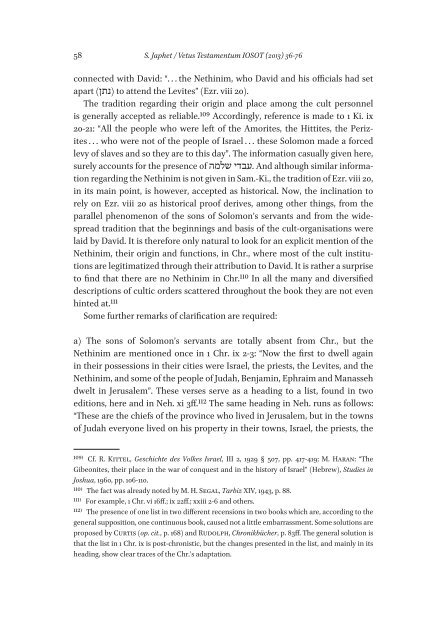Special Issue IOSOT 2013 - Books and Journals
Special Issue IOSOT 2013 - Books and Journals
Special Issue IOSOT 2013 - Books and Journals
You also want an ePaper? Increase the reach of your titles
YUMPU automatically turns print PDFs into web optimized ePapers that Google loves.
58 S. Japhet / Vetus Testamentum <strong>IOSOT</strong> (<strong>2013</strong>) 36-76<br />
connected with David: “. . . the Nethinim, who David <strong>and</strong> his officials had set<br />
apart (נתן) to attend the Levites” (Ezr. viii 20).<br />
The tradition regarding their origin <strong>and</strong> place among the cult personnel<br />
is generally accepted as reliable.109 Accordingly, reference is made to 1 Ki. ix<br />
20-21: “All the people who were left of the Amorites, the Hittites, the Perizites<br />
. . . who were not of the people of Israel . . . these Solomon made a forced<br />
levy of slaves <strong>and</strong> so they are to this day”. The information casually given here,<br />
surely accounts for the presence of שלמה .עבדי And although similar information<br />
regarding the Nethinim is not given in Sam.-Ki., the tradition of Ezr. viii 20,<br />
in its main point, is however, accepted as historical. Now, the inclination to<br />
rely on Ezr. viii 20 as historical proof derives, among other things, from the<br />
parallel phenomenon of the sons of Solomon’s servants <strong>and</strong> from the widespread<br />
tradition that the beginnings <strong>and</strong> basis of the cult-organisations were<br />
laid by David. It is therefore only natural to look for an explicit mention of the<br />
Nethinim, their origin <strong>and</strong> functions, in Chr., where most of the cult institutions<br />
are legitimatized through their attribution to David. It is rather a surprise<br />
to find that there are no Nethinim in Chr.110 In all the many <strong>and</strong> diversified<br />
descriptions of cultic orders scattered throughout the book they are not even<br />
hinted at.111<br />
Some further remarks of clarification are required:<br />
a) The sons of Solomon’s servants are totally absent from Chr., but the<br />
Nethinim are mentioned once in 1 Chr. ix 2-3: “Now the first to dwell again<br />
in their possessions in their cities were Israel, the priests, the Levites, <strong>and</strong> the<br />
Nethinim, <strong>and</strong> some of the people of Judah, Benjamin, Ephraim <strong>and</strong> Manasseh<br />
dwelt in Jerusalem”. These verses serve as a heading to a list, found in two<br />
editions, here <strong>and</strong> in Neh. xi 3ff.112 The same heading in Neh. runs as follows:<br />
“These are the chiefs of the province who lived in Jerusalem, but in the towns<br />
of Judah everyone lived on his property in their towns, Israel, the priests, the<br />
109) Cf. R. Kittel, Geschichte des Volkes Israel, III 2, 1929 § 507, pp. 417-419; M. Haran: “The<br />
Gibeonites, their place in the war of conquest <strong>and</strong> in the history of Israel” (Hebrew), Studies in<br />
Joshua, 1960, pp. 106-110.<br />
110) The fact was already noted by M. H. Segal, Tarbiz XIV, 1943, p. 88.<br />
111) For example, 1 Chr. vi 16ff.; ix 22ff.; xxiii 2-6 <strong>and</strong> others.<br />
112) The presence of one list in two different recensions in two books which are, according to the<br />
general supposition, one continuous book, caused not a little embarrassment. Some solutions are<br />
proposed by Curtis (op. cit., p. 168) <strong>and</strong> Rudolph, Chronikbücher, p. 83ff. The general solution is<br />
that the list in 1 Chr. ix is post-chronistic, but the changes presented in the list, <strong>and</strong> mainly in its<br />
heading, show clear traces of the Chr.’s adaptation.








![Am HaSefer [Volk des Buches] - Books and Journals](https://img.yumpu.com/20648352/1/174x260/am-hasefer-volk-des-buches-books-and-journals.jpg?quality=85)







